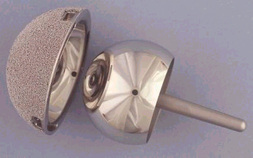Hip Resurfacing (Birmingham Hip)
|
Hip resurfacing or Birmingham Hip is a type of hip replacement. Currently, there are a lot of misconceptions about this procedure due to misleading advertisements. Below are some facts about this procedure:
Hip resurfacing is different from traditional total hip replacement in that the head of the femur is not removed. Instead, it is shaped with tools and then a metal cap is placed on top. Hip resurfacing is not a new procedure. It was developed and subsequently abandoned more than 25 years ago because of extremely high rates of wear of the socket (cup) resulting in bone damage, loosening and need for early revision surgery. To solve this problem, modern-day hip resurfacing uses a metal socket rather than the polyethylene socket that was used in the past. Hip resurfacing is NOT less invasive than total hip replacement. It involves cutting less bone from the femur, but the amount of cutting through the skin, muscles and tendons is usually a lot more than with a total hip. Today’s hip resurfacing has not been shown to improve patient outcomes:
|
The theoretical benefit of hip resurfacing is removal of less bone from the top of the femur. The reality is that saving that bone is not really helpful in the short run or the long run. The femoral component of a modern-day total hip replacement is incredibly reliable and durable, so saving 3 extra inches of the femur doesn't amount to any significant advantage. Simply put, femoral bone loss has not been an area of concern for hip surgeons. The data shows that more than 95% of femoral stems are still functioning well after 20 years of use.
There are still several unresolved issues and concerns with hip resurfacing arthroplasty, including:
There are still several unresolved issues and concerns with hip resurfacing arthroplasty, including:
|
Hip resurfacing requires use of a metal-on-metal ball and socket. There are now many reports of patients having severe reactions to the metallic debris that is produced with metal-on-metal hips. This can result in the need for repeat surgery and in some cases results in irreparable damage to bone and muscle.
In summary, hip resurfacing arthroplasty may be a reasonable option for patients requiring hip replacement, but it should by no means be heralded as a major breakthrough. It is simply an updated type of hip prosthesis that currently does not have any proven benefits over the current state-of-art in total hip replacement.
In summary, hip resurfacing arthroplasty may be a reasonable option for patients requiring hip replacement, but it should by no means be heralded as a major breakthrough. It is simply an updated type of hip prosthesis that currently does not have any proven benefits over the current state-of-art in total hip replacement.




